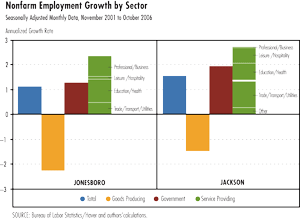District Overview: There Are Two Sides to Every (Employment Redistribution) Story!
The Memphis zone of the Eighth Federal Reserve District includes two metropolitan statistical areas (MSAs) outside of Memphis itself: Jonesboro, Ark., and Jackson, Tenn. In many ways, these two MSAs are very similar: They are roughly the same size in population with similar employment patterns and industry compositions. They also have followed similar paths of employment growth during the current econo-mic expansion; both Jonesboro and Jackson have exemplified the national shift in employment from goods production to service-providing sectors and have both outperformed their respective states’ rates of employment growth.
Nationally, this employment shift is often associated with movement from high-paying jobs to low-paying jobs. However, this broadly held sentiment belies a mixture of local experiences. Jonesboro has exceeded statewide growth of real personal income per capita, while Jackson has not.
During the expansion, both Jonesboro and Jackson have redistributed employment more rapidly than have their respective states. Between November 2001 and October 2006, Jonesboro’s concentration in service-providing employment grew by 0.4 percent annually relative to Arkansas’ statewide. Similarly, Jackson’s concentration increased by 0.5 percent when compared with Tennessee’s. In addition, the concentration of goods-providing employment in both MSAs fell by nearly 1 percent annually relative to their respective states’.
This ability to move employment into the expanding service sector has allowed total employment growth in both Jonesboro and Jackson to outpace their respective states’ since the beginning of the expansion. Through October 2006, private nonfarm payroll employment in Jonesboro grew by 1.1 percent annually compared with 0.8 percent statewide. In Jackson, private employment grew by 1.5 percent compared with 1 percent in Tennessee overall.
Although both Jonesboro and Jackson have added to their service-providing employment throughout this expansion, the composition of these additions has differed in important ways. Through October 2006, new service-sector growth in Jonesboro was concentrated in the professional and business services sector, which grew by 7.9 percent annually compared with 4.2 percent from January 1990 through the business cycle peak in March 2001. Professional and business services include professional, scientific and technical services, management of companies and enterprises, and administrative and waste services industries. Nationally, real earnings in these industries averaged $9.55 per hour as of October 2006. (The national average for goods-producing sectors was $8.93 per hour.)
In Jackson, new service-sector employment growth occurred mainly in leisure and hospitality services. Employment in these services grew by 4.4 percent annually through October 2006 compared with 2.4 percent from 1990 to March 2001. Leisure and hospitality services include arts, entertainment, recreation, accommodations and food services. In October 2006, real earnings in these industries averaged $4.78 per hour—roughly half the average hourly earnings in professional and business services.
Income growth, then, provides the real distinction between the Jonesboro and Jackson areas during the current expansion. Because employment growth in the Jackson metro area has been concentrated in low-wage industries, its income growth has only matched Tennessee’s. From 2001 through 2005, real personal income per capita increased by 1.3 percent annually in Jackson and statewide. The area’s leisure and hospitality employment growth has not been enough to bolster its overall income growth beyond the statewide trend.
If Jackson exemplifies the national sentiment regarding employment reallocation, Jonesboro provides a counterexample. Because of the area’s exceptional employment growth in high-wage industries, Jonesboro has outperformed Arkansas in income growth. From 2001 through 2005, real personal income per capita grew by 1.7 percent in Jonesboro compared with 1.5 percent statewide. Although there is fear that the national shift from a goods-producing economy to a service-providing one will produce lower wages, the Jonesboro experience demonstrates the potential for higher standards of living in response to employment reallocations.
Views expressed in Regional Economist are not necessarily those of the St. Louis Fed or Federal Reserve System.
For the latest insights from our economists and other St. Louis Fed experts, visit On the Economy and subscribe.
Email Us


